Linear regression - California Housing
Contents
42.45. Linear regression - California Housing#
In this assignment, we will predict the price of a house by its region, size, number of bedrooms, etc.
42.45.1. Introduction#
%matplotlib inline
import pandas as pd
import numpy as np
import matplotlib.pyplot as plt
import seaborn as sns
from sklearn.datasets import fetch_california_housing
from sklearn.linear_model import LinearRegression
import urllib.request
import pytest
import ipytest
import unittest
from sklearn.model_selection import train_test_split
from sklearn.impute import SimpleImputer
ipytest.autoconfig()
df = pd.read_csv("../../assets/data/housing.csv")
df.head()
| longitude | latitude | housing_median_age | total_rooms | total_bedrooms | population | households | median_income | median_house_value | ocean_proximity | |
|---|---|---|---|---|---|---|---|---|---|---|
| 0 | -122.23 | 37.88 | 41.0 | 880.0 | 129.0 | 322.0 | 126.0 | 8.3252 | 452600.0 | NEAR BAY |
| 1 | -122.22 | 37.86 | 21.0 | 7099.0 | 1106.0 | 2401.0 | 1138.0 | 8.3014 | 358500.0 | NEAR BAY |
| 2 | -122.24 | 37.85 | 52.0 | 1467.0 | 190.0 | 496.0 | 177.0 | 7.2574 | 352100.0 | NEAR BAY |
| 3 | -122.25 | 37.85 | 52.0 | 1274.0 | 235.0 | 558.0 | 219.0 | 5.6431 | 341300.0 | NEAR BAY |
| 4 | -122.25 | 37.85 | 52.0 | 1627.0 | 280.0 | 565.0 | 259.0 | 3.8462 | 342200.0 | NEAR BAY |
df.tail()
| longitude | latitude | housing_median_age | total_rooms | total_bedrooms | population | households | median_income | median_house_value | ocean_proximity | |
|---|---|---|---|---|---|---|---|---|---|---|
| 20635 | -121.09 | 39.48 | 25.0 | 1665.0 | 374.0 | 845.0 | 330.0 | 1.5603 | 78100.0 | INLAND |
| 20636 | -121.21 | 39.49 | 18.0 | 697.0 | 150.0 | 356.0 | 114.0 | 2.5568 | 77100.0 | INLAND |
| 20637 | -121.22 | 39.43 | 17.0 | 2254.0 | 485.0 | 1007.0 | 433.0 | 1.7000 | 92300.0 | INLAND |
| 20638 | -121.32 | 39.43 | 18.0 | 1860.0 | 409.0 | 741.0 | 349.0 | 1.8672 | 84700.0 | INLAND |
| 20639 | -121.24 | 39.37 | 16.0 | 2785.0 | 616.0 | 1387.0 | 530.0 | 2.3886 | 89400.0 | INLAND |
Features |
Informations |
|---|---|
|
A measure of how far west a house is; a higher value is farther west |
|
A measure of how far north a house is; a higher value is farther north |
|
Median age of a house within a block; a lower number is a newer building |
|
Total number of rooms within a block |
|
Total number of bedrooms within a block |
|
Total number of people residing within a block |
|
Total number of households, a group of people residing within a home unit, for a block |
|
Median income for households within a block of houses (measured in tens of thousands of US Dollars) |
|
Median house value for households within a block (measured in US Dollars) |
|
Location of the house w.r.t ocean/sea |
Source: Kaggle
df.info()
<class 'pandas.core.frame.DataFrame'>
RangeIndex: 20640 entries, 0 to 20639
Data columns (total 10 columns):
# Column Non-Null Count Dtype
--- ------ -------------- -----
0 longitude 20640 non-null float64
1 latitude 20640 non-null float64
2 housing_median_age 20640 non-null float64
3 total_rooms 20640 non-null float64
4 total_bedrooms 20433 non-null float64
5 population 20640 non-null float64
6 households 20640 non-null float64
7 median_income 20640 non-null float64
8 median_house_value 20640 non-null float64
9 ocean_proximity 20640 non-null object
dtypes: float64(9), object(1)
memory usage: 1.6+ MB
len(df)
20640
len(df.columns)
10
So, we have 20640 data points and 10 features. In those 10 features, 9 features are input features and the feature median_house_value is the target variable/label.
42.45.2. Task#
42.45.2.1. Task 1: Exploratory data analysis#
42.45.2.1.1. Split the data set into a training set and a test set#
train_data, test_data = train_test_split(df, test_size=0.1,random_state=20)
42.45.2.1.2. Checking data statistics#
train_data.describe(include='all').transpose()
| count | unique | top | freq | mean | std | min | 25% | 50% | 75% | max | |
|---|---|---|---|---|---|---|---|---|---|---|---|
| longitude | 18576 | NaN | NaN | NaN | -119.568 | 2.00058 | -124.35 | -121.79 | -118.49 | -118.01 | -114.49 |
| latitude | 18576 | NaN | NaN | NaN | 35.6302 | 2.13326 | 32.54 | 33.93 | 34.26 | 37.71 | 41.95 |
| housing_median_age | 18576 | NaN | NaN | NaN | 28.6611 | 12.604 | 1 | 18 | 29 | 37 | 52 |
| total_rooms | 18576 | NaN | NaN | NaN | 2631.57 | 2169.47 | 2 | 1445 | 2127 | 3149 | 39320 |
| total_bedrooms | 18390 | NaN | NaN | NaN | 537.345 | 417.673 | 1 | 295 | 435 | 648 | 6445 |
| population | 18576 | NaN | NaN | NaN | 1422.41 | 1105.49 | 3 | 785.75 | 1166 | 1725 | 28566 |
| households | 18576 | NaN | NaN | NaN | 499.277 | 379.473 | 1 | 279 | 410 | 606 | 6082 |
| median_income | 18576 | NaN | NaN | NaN | 3.87005 | 1.90022 | 0.4999 | 2.5643 | 3.5341 | 4.74273 | 15.0001 |
| median_house_value | 18576 | NaN | NaN | NaN | 206881 | 115238 | 14999 | 120000 | 179800 | 264700 | 500001 |
| ocean_proximity | 18576 | 5 | <1H OCEAN | 8231 | NaN | NaN | NaN | NaN | NaN | NaN | NaN |
42.45.2.1.3. Checking missing values#
train_data.isnull().sum()
longitude 0
latitude 0
housing_median_age 0
total_rooms 0
total_bedrooms 186
population 0
households 0
median_income 0
median_house_value 0
ocean_proximity 0
dtype: int64
print('The Percentage of missing values in total_bedrooms is: {}%'.format(train_data.isnull().sum()['total_bedrooms'] / len(train_data) * 100))
The Percentage of missing values in total_bedrooms is: 1.0012919896640826%
42.45.2.1.4. Checking values in the categorical feature(s)#
train_data['ocean_proximity'].value_counts()
<1H OCEAN 8231
INLAND 5896
NEAR OCEAN 2384
NEAR BAY 2061
ISLAND 4
Name: ocean_proximity, dtype: int64
sns.countplot(data=train_data, x='ocean_proximity')
<matplotlib.axes._subplots.AxesSubplot at 0x1f49b239f08>
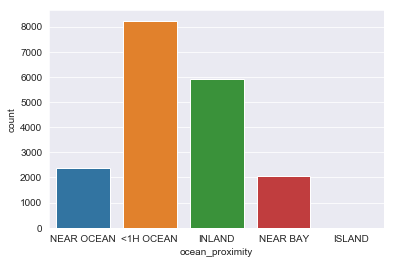
42.45.2.1.5. Checking Correlation Between Features#
correlation = train_data.corr()
correlation['median_house_value']
longitude -0.048622
latitude -0.142543
housing_median_age 0.105237
total_rooms 0.133927
total_bedrooms 0.049672
population -0.026109
households 0.065508
median_income 0.685433
median_house_value 1.000000
Name: median_house_value, dtype: float64
plt.figure(figsize=(12,7))
sns.heatmap(correlation,annot=True,cmap='crest')
<matplotlib.axes._subplots.AxesSubplot at 0x1f4a26c7b08>
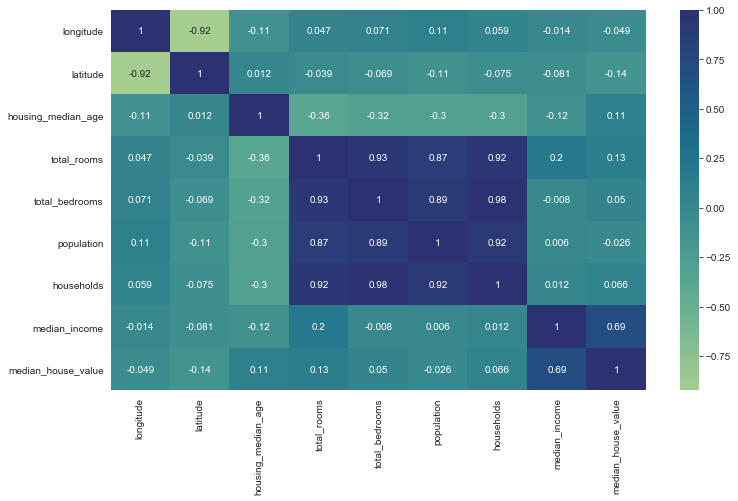
Some features like total_bedrooms and households are highly correlated. Same things for total_bedrooms and total_rooms and that makes sense because for many houses, the number of people who stay in that particular house (households) goes with the number of available rooms(total_rooms) and bed_rooms.
The other interesting insights is that the price of the house is closely correlated with the median income, and that makes sense too. For many cases, you will resonably seek house that you will be able to afford based on your income.
42.45.2.1.6. Plotting geographical features#
Since we have latitude and longitude, let’s plot it. It can help us to know the location of certain houses on the map and hopefully this will resemble California map.
plt.figure(figsize=(12,7))
sns.scatterplot(data = train_data, x='longitude', y='latitude')
<matplotlib.axes._subplots.AxesSubplot at 0x1f4a26efc48>
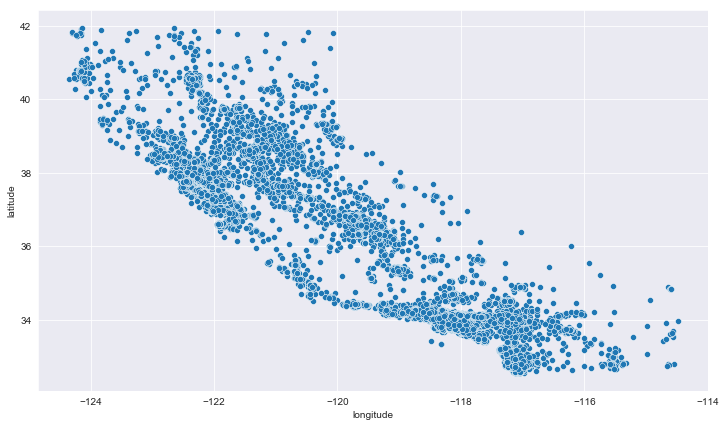
plt.figure(figsize=(12,7))
sns.scatterplot(data = train_data, x='longitude', y='latitude', hue='median_house_value')
<matplotlib.axes._subplots.AxesSubplot at 0x1f4a2788808>
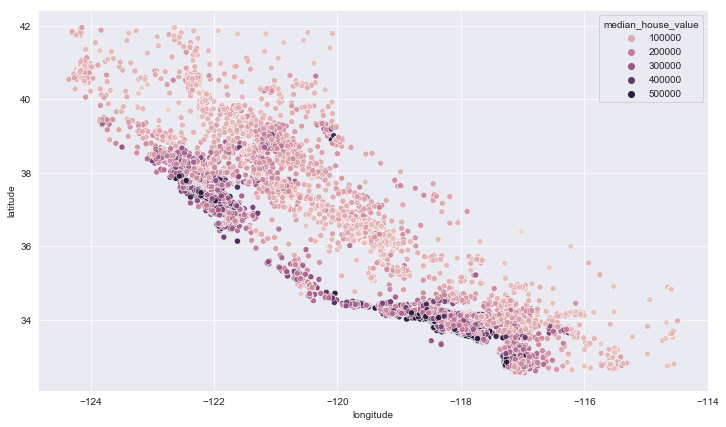
It makes sense that the most expensive houses are those close to sea. We can verify that with the ocean_proximity.
plt.figure(figsize=(12,7))
sns.scatterplot(data = train_data, x='longitude', y='latitude', hue='ocean_proximity',
size='median_house_value')
<matplotlib.axes._subplots.AxesSubplot at 0x1f4ad02ae08>
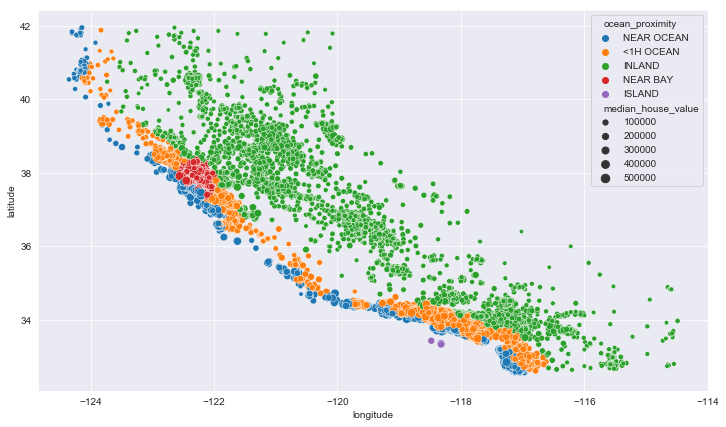
Yup, all houses near the ocean are very expensive compared to other areas.
42.45.2.1.7. Exploring Relationship Between Individual Features#
plt.figure(figsize=(12,7))
sns.scatterplot(data = train_data, x='median_house_value', y='median_income', hue='housing_median_age')
<matplotlib.axes._subplots.AxesSubplot at 0x1f4a27bb588>
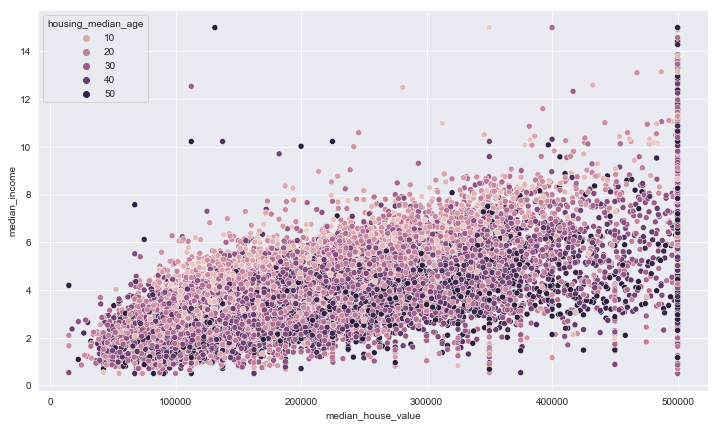
There are times you want to quickly see different plots to draw insights from the data. In that case, you can use grid plots. Seaborn, a visualization library provides a handy function for that.
sns.pairplot(train_data)
<seaborn.axisgrid.PairGrid at 0x1f4ad061988>
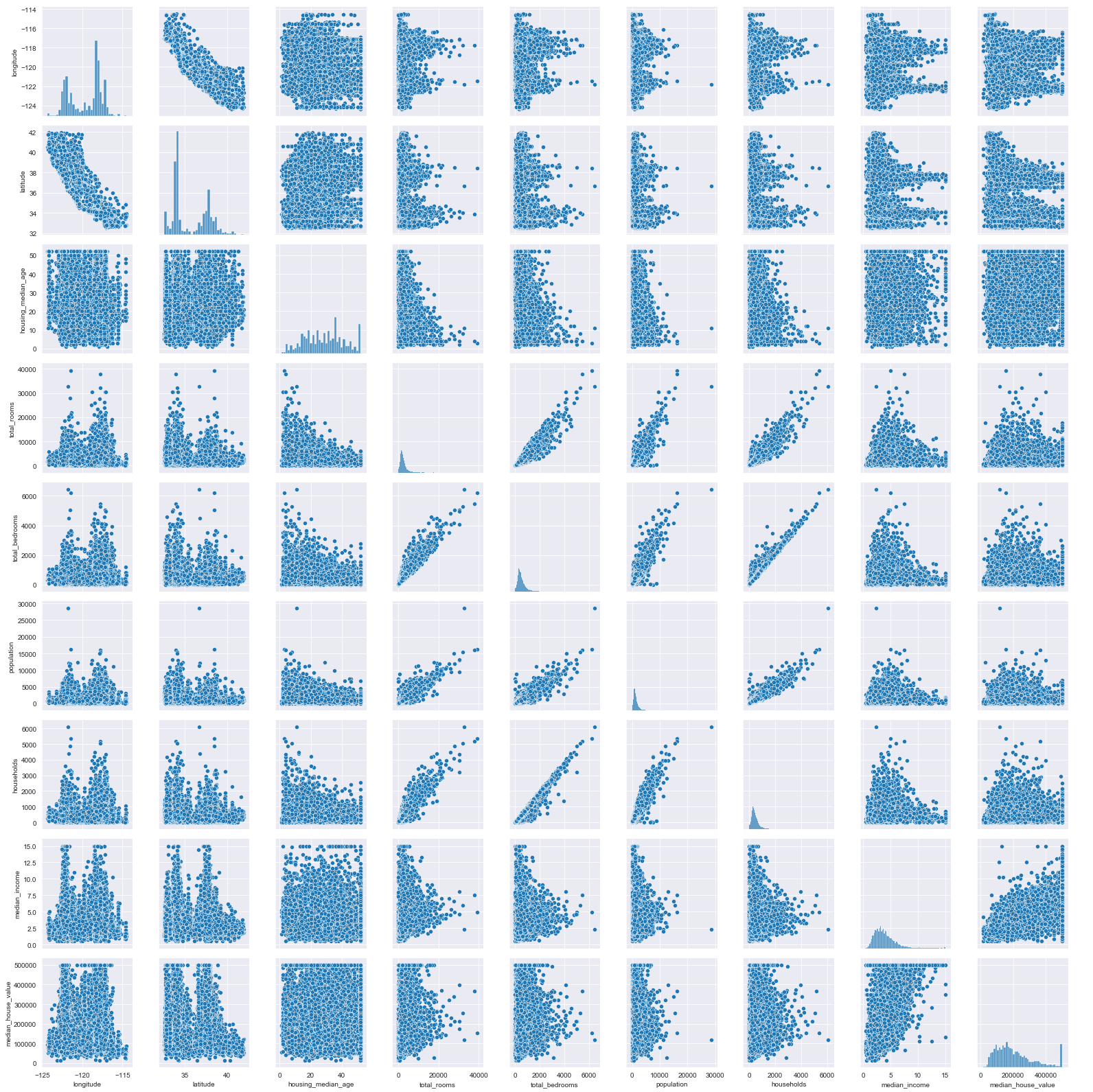
As you can see, it plots the relationship between all numerical features and histograms of each feature as well. But it’s slow…
To summarize the data exploration, the goal here it to understand the data as much as you can. There is no limit to what you can inspect. And understanding the data will help you build an effective ML systems.
42.45.2.2. Task 3: Data preprocessing#
42.45.2.2.1. Create the input data and output data for training the machine learning model#
Since we are going to prepare the data for the ML model, let’s create an input training data and the training label, label being median_house_value.
training_input_data = train_data.drop('median_house_value', axis=1)
training_labels = train_data['median_house_value']
training_input_data.head()
| longitude | latitude | housing_median_age | total_rooms | total_bedrooms | population | households | median_income | ocean_proximity | |
|---|---|---|---|---|---|---|---|---|---|
| 8101 | -118.21 | 33.80 | 41.0 | 1251.0 | 279.0 | 1053.0 | 278.0 | 3.2778 | NEAR OCEAN |
| 9757 | -121.44 | 36.51 | 31.0 | 1636.0 | 380.0 | 1468.0 | 339.0 | 3.2219 | <1H OCEAN |
| 16837 | -122.48 | 37.59 | 29.0 | 5889.0 | 959.0 | 2784.0 | 923.0 | 5.3991 | NEAR OCEAN |
| 11742 | -121.15 | 38.91 | 23.0 | 1654.0 | 299.0 | 787.0 | 299.0 | 4.2723 | INLAND |
| 1871 | -119.95 | 38.94 | 24.0 | 2180.0 | 517.0 | 755.0 | 223.0 | 2.5875 | INLAND |
training_labels.head()
8101 150800.0
9757 114700.0
16837 273000.0
11742 193100.0
1871 173400.0
Name: median_house_value, dtype: float64
42.45.2.2.2. Handling missing values#
In this example, we will fill the values with the mean of the concerned features.
# We are going to impute all numerical features
# Ideally, we would only impute bed_rooms because it's the one possessing NaNs
num_feats = training_input_data.drop('ocean_proximity', axis=1)
def handle_missing_values(input_data):
"""
Docstring
# This is a function to take numerical features...
...and impute the missing values
# We are filling missing values with mean
# fit_transform fit the imputer on input data and transform it immediately
# You can use fit(input_data) and then transform(input_data) or
# Or do it at once with fit.transform(input_data)
# Imputer returns the imputed data as a NumPy array
# We will convert it back to Pandas dataframe
"""
mean_imputer = SimpleImputer(strategy='mean')
num_feats_imputed = mean_imputer.fit_transform(input_data)
num_feats_imputed = pd.DataFrame(num_feats_imputed,
columns=input_data.columns, index=input_data.index )
return num_feats_imputed
num_feats_imputed = handle_missing_values(num_feats)
num_feats_imputed.isnull().sum()
longitude 0
latitude 0
housing_median_age 0
total_rooms 0
total_bedrooms 0
population 0
households 0
median_income 0
dtype: int64
The feature total_bedroom was the one having missing values. Looking above, we no longer have the missing values in whole dataframe.
42.45.2.2.3. Encoding categorical features#
Categorical features are features which have categorical values. An example in our dataset is ocean_proximity that has the following values.
training_input_data['ocean_proximity'].value_counts()
<1H OCEAN 8231
INLAND 5896
NEAR OCEAN 2384
NEAR BAY 2061
ISLAND 4
Name: ocean_proximity, dtype: int64
So we have 5 categories: <1H OCEAN, INLAND, NEAR OCEAN, NEAR BAY, ISLAND.
42.45.2.2.3.1. Mapping#
Mapping is simple. We create a dictionary of categorical values and their corresponding numerics. And after that, we map it to the categorical feature.
cat_feats = training_input_data['ocean_proximity']
cat_feats.value_counts()
<1H OCEAN 8231
INLAND 5896
NEAR OCEAN 2384
NEAR BAY 2061
ISLAND 4
Name: ocean_proximity, dtype: int64
feat_map = {
'<1H OCEAN': 0,
'INLAND': 1,
'NEAR OCEAN': 2,
'NEAR BAY': 3,
'ISLAND': 4
}
cat_feats_encoded = cat_feats.map(feat_map)
cat_feats_encoded.head()
8101 2
9757 0
16837 2
11742 1
1871 1
Name: ocean_proximity, dtype: int64
Cool, all categories were mapped to their corresponding numerals. That is actually encoding. We are converting the categories (in text) into numbers, typically because ML models expect numeric inputs.
42.45.2.2.3.2. Handling categorical features with Sklearn#
Sklearn has many preprocessing functions to handle categorical features. Ordinary Encoder is one of them. It does the same as what we did before with mapping. The only difference is implementation.
from sklearn.preprocessing import OrdinalEncoder
def ordinary_encoder(input_data):
encoder = OrdinalEncoder()
output = encoder.fit_transform(input_data)
return output
cat_feats = training_input_data[['ocean_proximity']]
cat_feats_enc = ordinary_encoder(cat_feats)
cat_feats_enc
array([[4.],
[0.],
[4.],
...,
[0.],
[0.],
[3.]])
42.45.2.2.3.3. One hot encoding#
One hot encoding is most preferred when the categories are not in any order and that is exactly how our categorical feature is. This is what I mean by saying unordered categories: If you have 3 cities and encode them with numbers (1,2,3) respectively, a machine learning model may learn that city 1 is close to city 2 and to city 3. As that is a false assumption to make, the model will likely give incorrect predictions if the city feature plays an important role in the analysis.
On the flip side, if you have the feature of ordered ranges like low, medium, and high, then numbers can be an effective way because you want to keep the sequence of these ranges.
In our case, the ocean proximity feature is not in any order. By using one hot, The categories will be converted into binary representation (1s or 0s), and the orginal categorical feature will be splitted into more features, equivalent to the number of categories.
from sklearn.preprocessing import OneHotEncoder
def one_hot(input_data):
one_hot_encoder = OneHotEncoder()
output = one_hot_encoder.fit_transform(input_data)
# The output of one hot encoder is a sparse matrix.
# It's best to convert it into numpy array
output = output.toarray()
return output
cat_feats = training_input_data[['ocean_proximity']]
cat_feats_hot = one_hot(cat_feats)
cat_feats_hot
array([[0., 0., 0., 0., 1.],
[1., 0., 0., 0., 0.],
[0., 0., 0., 0., 1.],
...,
[1., 0., 0., 0., 0.],
[1., 0., 0., 0., 0.],
[0., 0., 0., 1., 0.]])
Cool, we now have one hot matrix, where categories are represented in 1s or 0s. As one hot create more additional features, if you have a categorical feature having many categories, it can be too much, hence resulting in poor performance.
42.45.2.2.4. Scaling numerical#
Most machine learning models will work well when given small input values, and best if they are in the same range. For that reason, there are two most techniques to scale features:
Normalization where the features are scaled to values between 0 and 1. And
Standardization where the features are rescaled to have 0 mean and unit standard deviation. When working with datasets containing outliers (such as time series), standardization is the right option in that particular case.
## Normalizing numerical features
from sklearn.preprocessing import MinMaxScaler
scaler = MinMaxScaler()
num_scaled = scaler.fit_transform(num_feats)
num_scaled
array([[0.62271805, 0.13390011, 0.78431373, ..., 0.03676084, 0.04555172,
0.19157667],
[0.29513185, 0.4218916 , 0.58823529, ..., 0.05129013, 0.05558296,
0.18772155],
[0.18965517, 0.53666312, 0.54901961, ..., 0.09736372, 0.1516198 ,
0.3378712 ],
...,
[0.74340771, 0.02763018, 0.58823529, ..., 0.03942163, 0.07383654,
0.27298934],
[0.61663286, 0.16578108, 0.78431373, ..., 0.04764906, 0.11609933,
0.36398808],
[0.19269777, 0.55791711, 0.88235294, ..., 0.02653783, 0.07432988,
0.22199004]])
## Standardizing numerical features
from sklearn.preprocessing import StandardScaler
scaler = StandardScaler()
num_scaled = scaler.fit_transform(num_feats)
num_scaled
array([[ 0.67858615, -0.85796668, 0.97899282, ..., -0.33416821,
-0.58313172, -0.31168387],
[-0.93598814, 0.41242353, 0.18557502, ..., 0.04124236,
-0.42237836, -0.34110223],
[-1.45585107, 0.9187045 , 0.02689146, ..., 1.23170093,
1.11663747, 0.80468775],
...,
[ 1.27342931, -1.32674535, 0.18557502, ..., -0.26541833,
-0.12985994, 0.30957512],
[ 0.64859406, -0.71733307, 0.97899282, ..., -0.05283644,
0.54741244, 1.00398532],
[-1.44085502, 1.01246024, 1.37570172, ..., -0.59831252,
-0.12195403, -0.07959982]])
42.45.2.2.5. Putting all data preprocessing steps into a single pipeline#
We are going to do three things:
Creating a numerical pipeline having all numerical preprocessing steps (handling missing values and standardization)
Creating a categorical pipeline to encode the categorical features
Combining both pipelines into one pipeline.
42.45.2.2.5.1. Creating a numerical features pipeline#
from sklearn.pipeline import Pipeline
num_feats_pipe = Pipeline([
('imputer', SimpleImputer(strategy='mean')),
('scaler', StandardScaler())
])
num_feats_preprocessed = num_feats_pipe.fit_transform(num_feats)
num_feats_preprocessed
array([[ 0.67858615, -0.85796668, 0.97899282, ..., -0.33416821,
-0.58313172, -0.31168387],
[-0.93598814, 0.41242353, 0.18557502, ..., 0.04124236,
-0.42237836, -0.34110223],
[-1.45585107, 0.9187045 , 0.02689146, ..., 1.23170093,
1.11663747, 0.80468775],
...,
[ 1.27342931, -1.32674535, 0.18557502, ..., -0.26541833,
-0.12985994, 0.30957512],
[ 0.64859406, -0.71733307, 0.97899282, ..., -0.05283644,
0.54741244, 1.00398532],
[-1.44085502, 1.01246024, 1.37570172, ..., -0.59831252,
-0.12195403, -0.07959982]])
num_feats_pipe.steps[0]
('imputer', SimpleImputer())
num_feats_pipe.steps[1]
('scaler', StandardScaler())
42.45.2.2.5.2. Pipeline for transforming categorical features#
cat_feats_pipe = Pipeline([
('encoder', OneHotEncoder())
])
cat_feats_preprocessed = cat_feats_pipe.fit_transform(cat_feats)
type(cat_feats_preprocessed)
scipy.sparse.csr.csr_matrix
42.45.2.2.5.3. Final data processing pipeline#
from sklearn.compose import ColumnTransformer
# The transformer requires lists of features
num_list = list(num_feats)
cat_list = list(cat_feats)
final_pipe = ColumnTransformer([
('num', num_feats_pipe, num_list),
('cat', cat_feats_pipe, cat_list)
])
training_data_preprocessed = final_pipe.fit_transform(training_input_data)
training_data_preprocessed
array([[ 0.67858615, -0.85796668, 0.97899282, ..., 0. ,
0. , 1. ],
[-0.93598814, 0.41242353, 0.18557502, ..., 0. ,
0. , 0. ],
[-1.45585107, 0.9187045 , 0.02689146, ..., 0. ,
0. , 1. ],
...,
[ 1.27342931, -1.32674535, 0.18557502, ..., 0. ,
0. , 0. ],
[ 0.64859406, -0.71733307, 0.97899282, ..., 0. ,
0. , 0. ],
[-1.44085502, 1.01246024, 1.37570172, ..., 0. ,
1. , 0. ]])
type(training_data_preprocessed)
numpy.ndarray
42.45.2.3. Choosing and training a model#
from sklearn.linear_model import LinearRegression
reg_model = LinearRegression()
reg_model.fit(training_data_preprocessed, training_labels)
LinearRegression()
Great, that was fast! The model is now trained on the training set.
Before we evaluate the model, let’s take things little deep.
Have you heard of things called weights and bias? These are two paremeters of any typical ML model. It is possible to access the model paremeters, here is how.
# Coef or coefficients are referred to as weights
reg_model.coef_
array([-55263.30927452, -56439.9137407 , 13168.07604103, -7925.04690235,
27745.66496461, -50635.65732685, 35554.21578029, 72788.96303579,
-22102.99609181, -60373.27017952, 127304.48624811, -26150.80577065,
-18677.41420614])
# Intercept is what can be compared to the bias
reg_model.intercept_
241108.24591009185
42.45.2.4. Model evaluation#
from sklearn.metrics import mean_squared_error
predictions = reg_model.predict(training_data_preprocessed)
mse = mean_squared_error(training_labels, predictions)
rmse = np.sqrt(mse)
rmse
68438.90385283885
train_data.describe().median_house_value['mean']
206881.01130490957
42.45.2.4.1. Model evaluation with cross validation#
from sklearn.model_selection import cross_val_score
scoring = 'neg_root_mean_squared_error'
scores = cross_val_score(reg_model, training_data_preprocessed, training_labels, scoring=scoring, cv=10)
scores = -scores
scores.mean()
68491.40480256345
You can also use cross_val_predict to make a prediction on the training and validation subsets.
from sklearn.model_selection import cross_val_predict
predictions = cross_val_predict(reg_model, training_data_preprocessed, training_labels, cv=10)
mse_cross_val = mean_squared_error(training_labels, predictions)
rmse_cross_val = np.sqrt(mse_cross_val)
rmse_cross_val
68537.09704554168
To evaluate the model on the test set, we will have to preprocess the test dat as we preprocessed the training data. This is a general rule for all machine learning models. The test input data must be in the same format as the data that the model was trained on.
test_input_data = test_data.drop('median_house_value', axis=1)
test_labels = test_data['median_house_value']
test_preprocessed = final_pipe.transform(test_input_data)
test_pred = reg_model.predict(test_preprocessed)
test_mse = mean_squared_error(test_labels,test_pred)
test_rmse = np.sqrt(test_mse)
test_rmse
71714.55718082144
42.45.3. Acknowledgments#
Thanks to Nyandwi for creating the open-source course Linear Models for regression. It inspires the majority of the content in this chapter.


